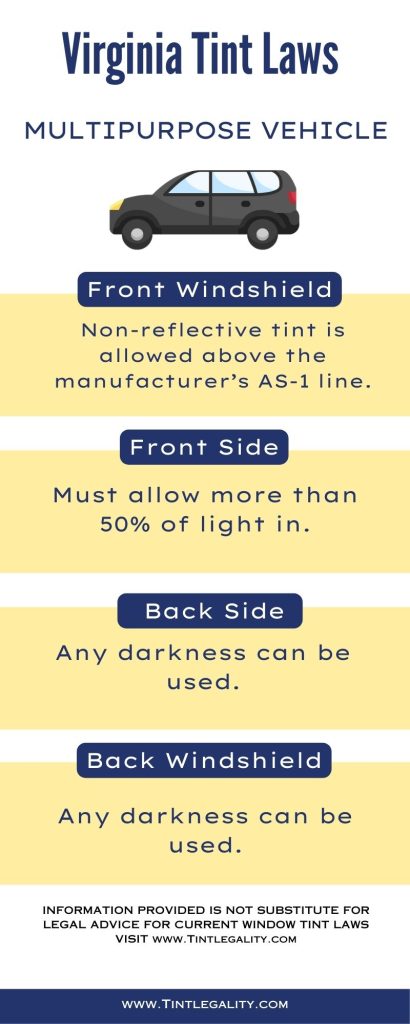If you’re a Virginia resident or planning to drive in the state, it’s crucial to be aware of the window tint laws.
Virginia tint laws were enacted in 1999 to establish clear guidelines regarding the darkness, reflectivity, and color of vehicle window tint.
Regulations Regarding Window Tint in Virginia
Virginia’s window tint laws specify a range of permissible visible light transmission (VLT) percentages for various windows on your vehicle.
VLT refers to the amount of visible light that can pass through a window’s tinted film.
| Window | Percentage of Light Allowed | Reflectivity | Additional Information |
|---|---|---|---|
| Windshield | Non-reflective tint along the top AS-1 line | N/A | Top 5 inches can be tinted |
| Front Side Windows | At least 50% | No more than 20% reflective | N/A |
| Back Side Windows (Sedan) | At least 35% | No more than 20% reflective | N/A |
| Back Side Windows (SUVs and Vans) | Any darkness | No more than 20% reflective | N/A |
| Rear Window (Sedan) | At least 35% | N/A | Requires dual side mirrors if tinted |
| Rear Window (SUVs and Vans) | Any darkness | N/A | Requires dual side mirrors if tinted |
Windshield
Non-reflective tint is permitted on the windshield along the manufacturer’s AS-1 line, essentially the top 5 inches of the windshield.
This ensures sufficient visibility for the driver while protecting from sun glare.
Front Side Windows
For front side windows, Virginia law states that the window tint must allow at least 50% of light to pass through.
This rule is in place to ensure visibility for the driver and allow law enforcement to maintain eye contact during traffic stops for safety reasons.
Back Side Windows
Moving onto the back side windows, the rules are a bit different.
For sedans, the tint must allow 35% of light to pass through.
However, for SUVs and vans, there’s more flexibility; any level of darkness can be used.
Rear Window
As for the rear window, the laws are identical to those for the back-side windows.
Sedans require at least 35% of light transmission, while for SUVs and vans, any darkness level is acceptable.


Additional Regulations
Additional regulations in Virginia include requiring dual side mirrors if back windows are tinted. Red, yellow, and amber tints are not allowed.
Also, a 7% variance in tint darkness is permitted.
Reflection
When it comes to reflection, window tint in Virginia can reflect incoming light to reduce glare and heat.
However, this is subject to some rules too.
For both sedans and SUVs/vans, front and back side windows must be no more than 20% reflective.
Medical Exemptions
Virginia allows for medical exemptions to window tinting laws.
For instance, if a doctor prescribes a darker tint due to a medical condition like light sensitivity, the window can have a darker tint than what’s typically allowed.
Color Restrictions
In Virginia, tint colors such as red, yellow, and amber are not permitted.
Such colors can confuse other drivers, potentially leading to accidents, so the law mandates avoiding these colors.
Side Mirrors
If you have a tinted rear window, your vehicle must have dual-side mirrors.
This is to ensure that the driver has sufficient visibility, even if the tinted rear window reduces the view.
Exceptions to Legal Limits
Exceptions to these tint limits exist for certain vehicles and circumstances.
For instance, vehicles used by law enforcement, the Department of Corrections, local correctional facilities, and certain medical transport services may have darker tints.
Penalties for Breaking the Law
Fines
If you violate Virginia’s window tint laws, you can expect fines and other penalties. The severity increases with repeated offenses:
- First Conviction: Classified as a Class 3 misdemeanor, which can result in a fine of up to $500.
- Second Conviction: Classified as a Class 2 misdemeanor, which can lead to higher fines and possible jail time.
- Third Conviction: This carries even higher fines and longer possible jail times.
Other Penalties
Aside from fines, other penalties include having to remove the illegal tint from your vehicle and possible points on your driving record, which can lead to higher insurance rates.
Penalties for Non-Compliance
Non-compliance with Virginia tint laws can also lead to potential safety risks.
Having a darker tint than allowed by law can limit your visibility, particularly at night or in poor weather, leading to potential accidents.
Knowing and understanding Virginia’s tint laws are crucial not just to stay within the legal limits but also for your safety and the safety of others on the road
References:
https://en.wikipedia.org/wiki/Virginia
https://law.lis.virginia.gov/vacode/title46.2/chapter10/section46.2-1052/
https://law.lis.virginia.gov/vacode/title46.2/chapter10/section46.2-1052/
https://www.dmv.virginia.gov/drivers/#medical/sunshading.asp
https://www.dmv.virginia.gov/drivers/#medical/sunshading.asp